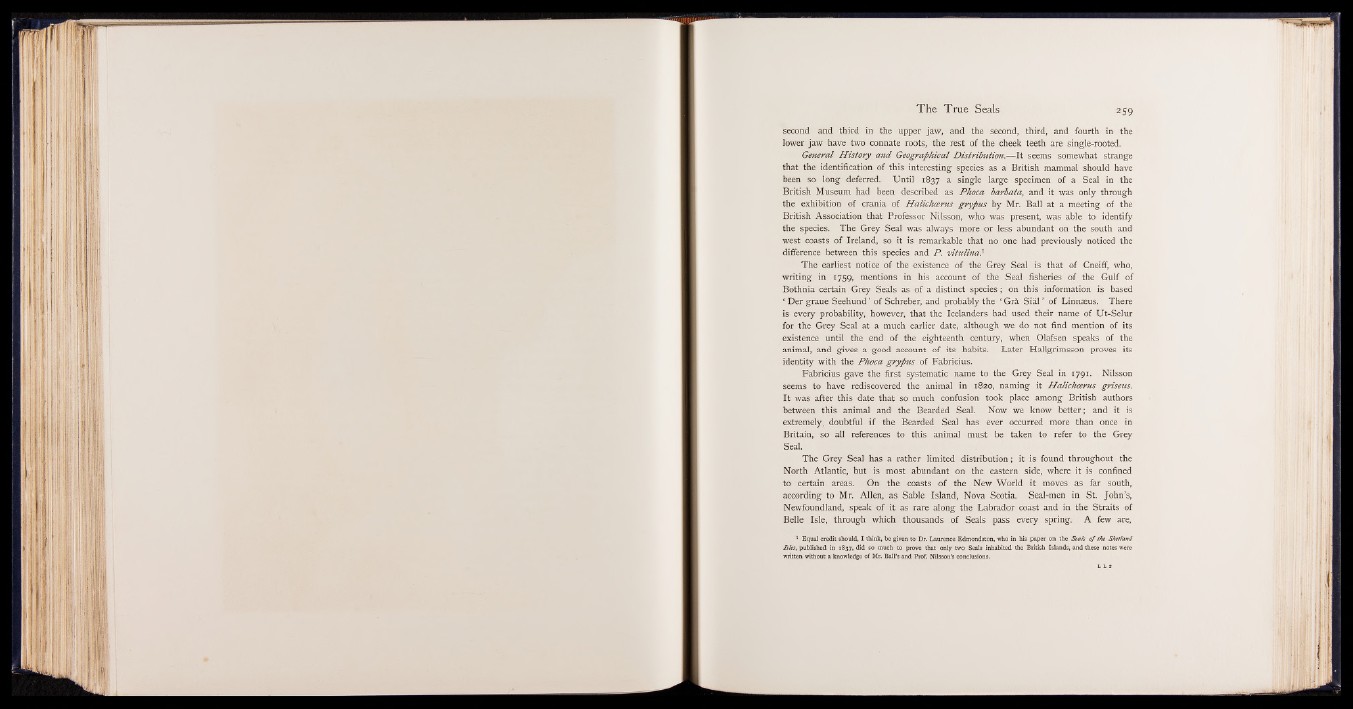
second and third in the upper jaw, and the second, third, and fourth in the
lower jaw have two connate roots, the rest of the cheek teeth are single-rooted.
General History and Geographical Distribution.— It seems somewhat strange
that the identification of this interesting species as a British mammal should have
been so long deferred. Until 1837 a single large specimen of a Seal in the
British Museum had been described as Phoca barbata, and it was only through
the exhibition of crania of Halichoerus grypus by Mr. Ball at a meeting of the
British Association that Professor Nilsson, who was present, was able to identify
the species. The Grey Seal was always more or less abundant on the south and
west coasts of Ireland, so it is remarkable that no one had previously noticed the
difference between this species and P. vitulina.1
The earliest notice of the existence of the Grey Seal is that of Cneiff, who,
writing in 1759, mentions in his account of the Seal fisheries of the Gulf of
Bothnia certain Grey Seals as of a distinct species; on this information is based
1 Der graue Seehund ’ of Schreber, and probably the ‘ Gr3. Sial ’ of Linnaeus. There
is every probability, however, that the Icelanders had used their name of Ut-Selur
for the Grey Seal at a much earlier date, although we do not find mention of its
existence until the end of the eighteenth century, when Olafsen speaks of the
animal, and gives a good account of its habits. Later Hallgrimsson proves its
identity with the Phoca grypus of Fabricius.
Fabricius gave the first systematic name to the Grey Seal in 1791. Nilsson
seems to have rediscovered the animal in 1820, naming it Halichoerus griseus.
It was after this date that so much confusion took place among British authors
between this animal and the Bearded Seal. Now we know better; and it is
extremely, doubtful if the Bearded Seal has ever occurred more than once in
Britain, so all references to this animal must be taken to refer to the Grey
Seal.
The Grey Seal has a rather limited distribution; it is found throughout the
North Atlantic, but is most abundant on the eastern side, where it M confined
to certain areas. On the coasts of the New World it moves as far south,
according to Mr. Allen, as Sable Island, Nova Scotia. Seal-men in St. John’s,
Newfoundland, speak of it as rare along the Labrador coast and in the Straits of
Belle Isle, through which thousands of Seals pass every spring. A few are,
1 Equal credit should, I think, be given to Dr. Laurence Edmondston, who in his paper on the Seals o f the Shetland
Isles, published in 1837, did so much to prove that only two Seals inhabited the British Islands, and these notes were
written without a knowledge of Mr. Ball’s and Prof. Nilsson’s conclusions.